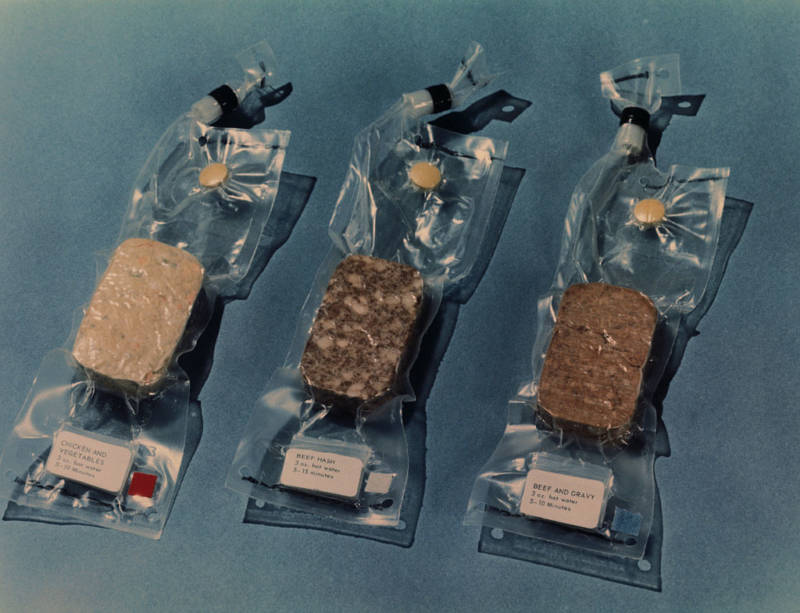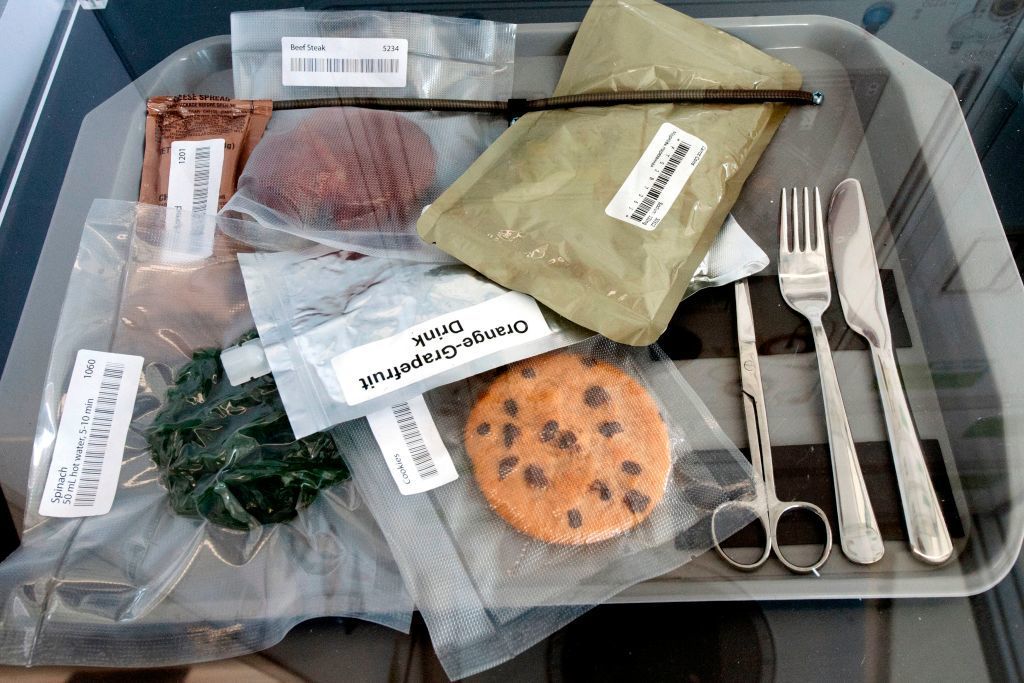50 Years After Apollo 11, Here's What (And How) Astronauts Are Eating

In 1969, Charles Bourland flew to Houston to interview for a food scientist position at NASA's Johnson Space Center. From his hotel's lobby, he watched with millions of Americans as Apollo astronauts took their first steps on the moon.
It was a "pretty impressive thing" to witness while considering a NASA job, he remembers with a chuckle.
Bourland, now 82, came onboard that year; he retired in 2000. In his 31 years as a NASA food scientist, he did a lot of things to improve the quality of what astronauts eat, including adding potassium back into processed goods.
Being a NASA food scientist can be tricky — the team has had to address a range of challenges, from extending shelf lives by years to maximizing nutritional value and minimizing weight to keeping dishes from flying apart in microgravity.
NPR spoke to Bourland and Vickie Kloeris, a food scientist and food systems manager at NASA from 1989 to 2018, about their craft and its evolution. To commemorate Apollo 11's 50th anniversary this month, here's how eating in space has evolved — from John Glenn's first bite of applesauce to today's beloved Sriracha bottles.
Then: Bread.
Now: Specially engineered fast-food tortillas.
When Kloeris joined NASA's food program in the 1980s, food teams sent bread into space — but it wasn't ideal. Bread tends to crumble, and in microgravity, crumbs fly everywhere, contaminating the surrounding air and potentially jamming sensitive equipment. It also has a very short shelf life, growing moldy in just a few days.
But in the mid-1980s, a payload specialist from Mexico named Rodolfo Neri Vela went into space and requested a different type of bread product — tortillas.
"Crew members saw how easy it was to take something and roll it up," Kloeris says. "A lot easier to deal with than the bread and crumbs. After that it was, 'Forget the bread, let's bring up tortillas!' "
This solved the crumbs problem, but not the mold problem. Tortillas back then only lasted eight to 10 days in orbit. So food scientists at the Johnson Space Center began experimenting, drawing on preservation techniques the military used for its bread products. This involved reducing the water activity (free water) in the bread and packaging it without oxygen to prevent mold. In this way, they got their tortillas to last several months. But they couldn't get them to last any longer — until they took some inspiration from the commercial food industry.
In the 1990s, Taco Bell began marketing a new soft taco-making kit. The tortillas in this kit, they advertised, had a shelf life of nine months.
As soon as the food scientists saw this claim, "We knew that [the Taco Bell product] had to be a low water-activity tortilla," Kloeris says. "We tested it, and sure enough," the tortillas actually lasted even longer, often over a year. NASA started buying Taco Bell tortillas and repackaging them for their astronauts.
Nowadays, NASA buys the same tortillas, but prepackaged, from the military, a source for many NASA food items.
Then: Fewer options.
Now: A more robust menu.
During the Apollo era, astronauts had a fairly limited menu. They had fewer than 70 items to choose from, including drinks, condiments and entrees, according to a menu that Bourland provided to NPR. Nowadays, astronauts select their choices from a core menu of more than 200 items, including entrees like beef steak, lasagna and tuna casserole, which they heat up in a small machine. Astronauts also have a limited number of "preference containers" for foods off the core menu. For instance, astronauts who love certain packaged items, like a type of cereal, can request them for their flight. Space travelers from Japan or Europe, whom NASA also feeds, can bring dishes from their home countries.
In order to make it onto the space station as part of the core menu or as a preference item, food must meet "microbiological and shelf-life requirements," Kloeris says. In other words, no raw chicken, eggs or any other food likely to spoil quickly.

Then: Zero frozen food.
Now: Occasional ice cream bites.
The International Space Station lacks dedicated freezer space for food (the freezers are all reserved for medical/scientific samples). Still, NASA food scientists and providers have found a way to send astronauts the occasional cold treat.
That's thanks to the SpaceX cargo shuttle, which brings supplies up to the space station periodically and sends medical samples back to Earth. The shuttle's freezer is empty when it goes up, so "we'll get to send 'em, like, Dove bites [or other] frozen ice cream treats," Kloeris says. But once crew members receive the ice cream, they must eat it fairly quickly so they can load the freezer with the medical samples for the trip back to Earth.
Note: Those freeze-dried ice cream bars you see in galactic packaging at space-related gift shops? Those aren't actually eaten in space, according to Kloeris. The treat "certainly meets the shelf life and microbiological requirements, but it doesn't taste like real ice cream, and it's very crumbly," she says. Although, she says, Apollo-era astronauts ate freeze-dried ice cream at least once in cube form.
Then: Cubes and "spoon bowl packages."
Now: Pouches, trays and Velcro.
The earliest space food tasted pretty terrible. According to NASA's own website, "Astronauts had to endure bite-sized cubes, freeze-dried powders, and semi-liquids stuffed in aluminum tubes." Astronauts ate very little on these early flights, partly because the food wasn't very appetizing, but also because they wanted to avoid going to the restroom at all costs (they didn't have zero-gravity toilets until the 1970s).
Taste and texture improved during the Apollo era, but astronauts still didn't have as much variety, and nearly everything was freeze-dried and needed to be rehydrated. The Apollo era did see the development of a spoon-bowl package, which allowed astronauts to eat with a spoon instead of out of a squeeze tube — provided the food was liquidy enough. "Surface tension will keep the food in [a bowl] if it's wet," Bourland says. Eating with utensils in space comes with a steep learning curve, though, because in microgravity, "as much food is on the bottom of the spoon as gets on the top."
Today, astronauts eat most of their meals directly from their pouches, Kloeris says, even foods like steak. They stick pouches to tables using Velcro.
A lot of food is still freeze-dried and dehydrated, but nowadays, many meals are also thermostabilized (processed using heat and pressure) or irradiated, a process that reduces microorganisms and insects on food by exposing it to ionizing radiation.
Never: Sprite, alcohol and perishables.
Always: Tang, shrimp cocktail.
Astronauts must go without many popular foods and beverages on the International Space Station, including soda — the carbonation goes wacky in space and could wreak havoc on the digestive system; perishable items, because food poisoning would be pretty terrible in space; and alcohol, because it could damage water recovery equipment and impair astronauts' judgment.
And some have been staples since the early missions. Tang, a beverage nearly synonymous with spaceflight, remains popular among astronauts today. What you won't hear about as often — shrimp cocktail. "Shrimp cocktail has almost forever been [one of] their favorite foods," Bourland says (and Kloeris agrees).
This is for a couple of reasons. Shrimp freeze-dries well, and it tastes essentially the same as normal shrimp. Plus, it's a bit spicy, which astronauts appreciate, Kloeris says. She theorizes that this is because in the absence of gravity, heat doesn't always rise and thus the odors don't waft into astronauts' nostrils in the same way. Others have noted that astronauts experience nasal congestion in microgravity, dulling their sense of smell and taste. "A lot of astronauts tell me that their taste buds feel duller [in space]," Kloeris says. Spicy foods thus deliver a much-needed kick. Sriracha hot sauce is popular as well: See if you can spot a bottle in this video of an astronaut making a tortilla peanut butter and jelly "space taco."
Copyright 2019 NPR. To see more, visit NPR.org.